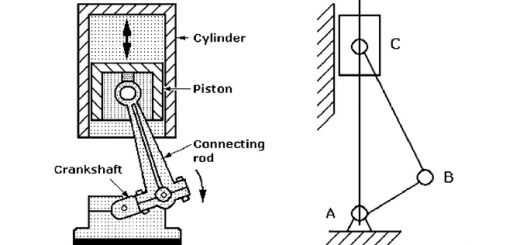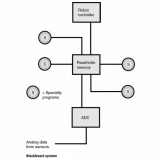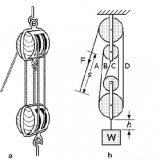Robotic Mechanisms – SPUR GEARS 51031
Spur gears or straight-cut gears are the simplest type of gear. They consist of a cylinder or disk with the teeth projecting radially, and although they are not straight-sided in form, the edge of each tooth is straight and aligned parallel to the axis of rotation. These gears can be meshed together correctly only if they are fitted to parallel shafts.
Spur Gears are Used to Control Power Transmission in These Ways
1. Changing the direction through which power is transmitted (i.e. parallel, right angles, rotating, linear etc.)
2. Changing the amount of force or torque
3. Changing RPM
Spur Gears, are cogged wheels whose cogs or teeth project radially and stand parallel to the axis.
TECHNICAL DETAILS of SPUR GEARS
Diametral Pitch of Spur Gears (DP)
The Diametral Pitch describes the gear tooth size. The Diametral Pitch is expressed as the number of teeth per inch of Pitch Diameter. Larger gears have fewer teeth per inch of Diametral Pitch. Another way of saying this; Gear teeth size varies inversely with Diametral Pitch.
Pitch Diameter of Spur Gears (D)
The Pitch Diameter refers to the diameter of the pitch circle. If the gear pitch is known then the Pitch Diameter is easily calculated using the following formula;
P = N/P
PD = Pitch Diameter, N = Number of teeth on the gear, P = Diametral Pitch (Gear Size)
PD = N/P = 36 /24 = 1,5″
The Pitch Diameter is used to generate the Pitch Circle.
The Pitch Circle
The pitch circle is the geometrical starting point for designing gears and gear trains. Gear trains refer to systems of two or more meshing gears. The pitch circle is an imaginary circle that contacts the pitch circle of any other gear with which it is in mesh. The pitch circle centers are used to ensure accurate center-to-center spacing of meshing gears.
SPUR GEAR IDEAS
Intermittent Motion Spur Gear
MAKING SPUR GEARS
Broaching External Spur Gears on Lathe
Gear Making – Cutting a Spur Gear for the AL-54B Lathe
Making Plastic Spur Gears
GEAR TERMS
Addendum (A): The addendum refers to the distance from the top of the tooth to the Pitch circle.
Dedendum (B): The Dedendum refers to the distance from the Pitch circle to the root circle.
Clearance (C) : Refers to the radial distance between the top and bottom of gears in mesh. Some machinists and mechanics refer to clearance as “play” or the degree of looseness between mating parts.
Whole Depth (WD) : Refers to the distance from the top of the tooth to the bottom of the tooth.
Pressure Angle (PA) (Choose either 14.5 or 20 degrees) : The pressure angle figures into the geometry or form of the gear tooth. It refers to the angle through which forces are transmitted between meshing gears. 14.5-degree tooth forms were the original “standard” gear design. While they are still widely available, the 20-degree PA gear tooth forms have wider bases and can transmit greater loads. Note: 14.5-degree PA tooth forms will not mesh with 20-degree PA teeth. Be certain to verify the Pressure angle of the gears you use.
Center Distance : The center distance of 2 spur gears is the distance from the center shaft of one spur gear to the center shaft of the other.
Spur Gear Calculations – Formulas
This is a chart of formulas used in calculating spur gear information based on standard gearing practices.
The spur gear formulas here are based on the “Diametral Pitch system (DP).
These formulas can be used with Circular Pitch and Module systems by first converting them to the Diametral Pitch
To convert a Circular Pitch (CP) to DP – Divide 3.1416 by the circular pitch
To convert the Module (Mod) to DP - Divide the 25.4 by the module
| Diametral Pitch | The circular pitch | Divide 3.1416 by the circular pitch |
Pd = 3.1416 / CP |
| Diametral Pitch |
|
Divide the number of teeth by the pitch diameter |
Pd = N / D |
| Diametral Pitch |
|
Divide number of teeth + 2 by the outside diameter |
Pd = (N+2) / OD |
| Diametral Pitch |
|
Divide the base pitch by the cosine of the pressure angle then divide by 3.1416 |
Pd = (BP / Cos PA) / 3.1416 |
| Pitch Diameter |
|
Divide the number of teeth by the diametral pitch |
D = N / Pd |
| Pitch Diameter |
|
Divide the product of the outside diameter + number of teeth by the number of teeth + 2 |
D = (OD x N) / (N+2) |
| Pitch Diameter |
|
Subtract 2 divided by the diametral pitch from the outside diameter |
D = OD – (2/ Pd) |
| Pitch Diameter |
|
Multiply addendum by the number of teeth |
D = A x N |
| Pitch Diameter |
|
Divide the base diameter by the cosine of the pressure angle |
D = BD / (Cos Pa) |
| Outside Diameter |
|
Divide number of teeth + 2 by the diametral pitch |
OD = (N+2) / Pd |
| Outside Diameter |
|
Two divided by the diametral pitch plus pitch diameter |
OD = (2 / Pd) + D |
| Outside Diameter |
|
Number of teeth + 2, divided by the quotient of number of teeth divided by the pitch diameter |
OD = (N+2) / (N / D) |
| Outside Diameter |
|
Multiply the number of teeth + 2 by the addendum |
OD = (N + 2) x A |
| Number Of Teeth |
|
Multiply the pitch diameter by the diametral pitch |
N = D x Pd |
| Number Of Teeth |
|
Multiply the outside diameter by the diametral pitch and subtract 2 |
N = (OD x Pd) – 2 |
| Thickness Of Tooth |
|
Divide 1.5708 by the diametral pitch |
t = 1.5708 / Pd |
| Addendum |
|
Divide 1 by the diametral pitch |
a = 1 / Pd |
| Dedendum |
|
Divide 1.157 (or 1.25) by the diametral pitch |
b = 1.157 / Pd |
| Working Depth |
|
Divide 2 by the diametral pitch |
hk = 2 / Pd |
| Whole Depth |
|
Divide 2.157 (or 2.25) by the diametral pitch |
ht = 2.157 / Pd |
| Clearance |
|
Divide .157 (or .250) by the diametral pitch |
c = .157 / Pd |
| Clearance |
|
Divide thickness of tooth at the pitchline by 10 |
c = t / 10 |
| Operating Diametral Pitch |
|
Add the number of teeth in both gears and divide by 2 then divide by the center distance |
PdO = ((n1 + n2)/2) / C |
| Center Distance |
|
Add the number of teeth in both gears and divide by 2 then divide by the normal diametral pitch |
C = ((n1 + n2)/2) / Pnd |
| Operating Center Distance |
|
Add the number of teeth in both gears and divide by 2 then divide by the operating diametral pitch |
Co = ((n1 + n2)/2) / Pod |
| Base Diameter |
|
Multiply the pitch diameter by the cosine of the pressure angle |
Db = PD x (cos PA) |
| Pressure Angle |
|
Divide the base diameter by the pitch diameter |
cosPA = Db / D |
| Pressure Angle |
|
Divide Pi by the diametral pitch, then divide by the base pitch |
cosPA = (3.1416 / Pd) / Pb |
| Base Pitch |
|
Divide the diametral pitch by Pi, then multiply by the cosine of the pressure angle |
Pb = (Pd / 3.1416) x (cos PA) |
Spur Gear Materials
17-4 PH Stainless Steel
-Type 17-4PH (“precipitation-hardening”) stainless steel is arguably the most common of stainless steels. This type of stainless steel has a high level of strength and a moderate level of corrosion resistance.
-Type 17-4PH stainless steel can be found in a wide variety of applications including medical devices, aerospace platforms, as well as chemical and food processing.
303 Stainless Steel
-Type 303 Stainless Steel is another popular form of stainless steel that posses non-magnetic properties. This type of stainless steel is strong, but not as strong as 17-4PH, and it cannot be heat-treated.
-Type 303 stainless steel has a high level of resistance to corrosion, and is popular with applications involving surgical devices.
Aluminum Anodized
To guard against oxidation, aluminum can be strengthened and be made more durable through the anodizing process. This process involved placing the material in a chemical bath. After an electric is passed, a coating for “anodized aluminum” is formed, thus provided increased durability.
Brass
Brass is a metal that is an alloy of copper and zinc. Brass is commonly used in applications where low friction is required. Hence, using brass for gear manufacturing is popular. However, brass is much more susceptible to stress fractures than stainless steel.
Cast Polyurethane
Cast Polyurethane is advantageous in that it can be shaped into virtually any kind of shape. It is one of the strongest and abrasive-resistant elastomers available. Cast polyurethane can be developed with varying levels of coefficients of friction, be made flame resistant, and can be made to be flexible at very low temperatures.







